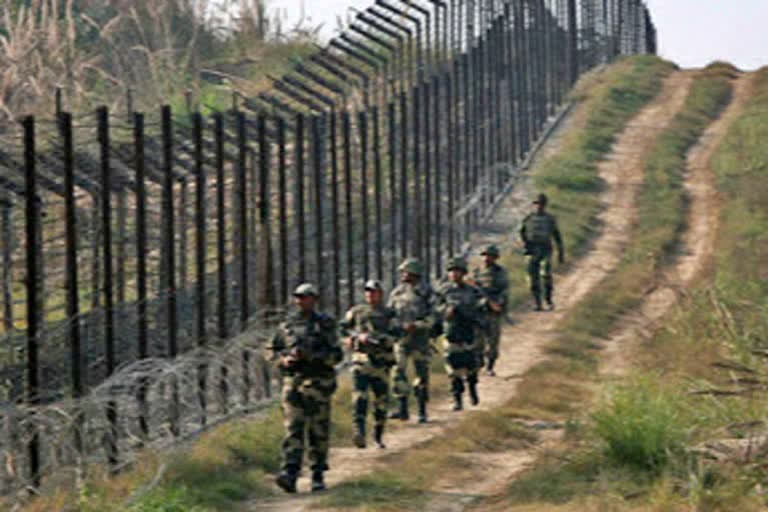Hyderabad: Line of Control (LoC) which is an imaginary line that was demarcated in 1947-48. It is a line where the armies of India and Pakistan were located when the ceasefire of 1948 came into being after the first India-Pakistan Conflict, in 1947-48.
It was called the Ceasefire Line (CFL) after it got demarcated under the Suchetgarh Agreement of 1972, which followed the Shimla Agreement. It differs from the international border (IB), which is the legal uncontentious boundary between two states.
There was no LoC before 1972 Shimla Agreement was signed between India and Pakistan.
The Simla Agreement of 1972 replaced the earlier Ceasefire Line (CFL) of 1949 with the LoC in Jammu and Kashmir. Although the LoC bears similarities to the CFL, it is the result of several minor territorial readjustments between India and Pakistan resulting from the war of 1971.
Unlike the CFL, which was monitored de jure by the United National Observers Group (UNMOGIP) as an international third party, the sanctity of the LoC is maintained de facto by Indian and Pakistani troops on either side of the border.
The IB is manned by police forces on a non-tactical basis to prevent unauthorised trans-border movement, smuggling and other such illegal activity.
The LoC is, however, different. For one, it is manned by the armies on both sides.
A history of ceasefire violations duels on LOC
After the delineation of the LoC in 1972, the border remained peaceful for almost a decade, with only occasional violations.
CFVs increased toward the end of the 1980s and heightened in the1990s, as the Kashmir insurgency peaked.
Cross-LoC firing intensified after India began constructing the fence on its side in 2001.
After the CFA of 2003, both sides reported negligible CFVs for five years, indicating that the Composite Dialogue between the two countries yielded encouraging results on the border.
But after Mumbai Terror attacks, the peace process dwindled and CFVs on the border in began to rise gradually.
The violations on the IB/WB and the LoC spiked in 2013. Since then CFVs have increased every year.
In 2017, Pakistan accused India of 1,970 violations and in 2018 India recorded, 936 CFVs by Pakistan – an all-time high in the 15 years since the signing of the CFA.
In May 2018, India announced a Non-Initiation of Combat Operations in J&K – called the Ramzan ceasefire – followed by the reinstatement of the 2003 CFA. Hostilities soon broke out and Violations escalated in 2019 and 2020.
The 2003 ceasefire agreement:
On an intervening night between November 25 and 26, 2003, a decision was communicated via the Director-General of Military Operations (DGMO) of both sides. Pakistan had announced a unilateral cessation to the ongoing hostilities on the LoC and IB/WB in JK. This decision was and became known as the ceasefire Agreement CFA.
The CFA of 2003 is an unwritten mutual commitment which seeks to uphold the legitimacy of the LoC and reinstate various mechanisms put in place since the 1949 and 1972 agreements, such as hotlines and flag meetings, for the peaceful maintenance of the Indo-Pak borders in JK.
Forms of ceasefire violations:
The actions on the LoC and Jammu IB currently underway involve major breaches of the ceasefire, which means regular fire assaults, using lethal weapons. These also affect the local population, thus drawing more attention.
Statistics on ceasefire violations by Pakistan at LOC:
From 2010 to September 2020, Pakistan violated the peace pact on borders at least 11,572 times, killing 240 Indians -- including 122 civilians and 118 security force personnel and leaving 673 civilians and 594 force personnel injured.
Compared to 2010, the incidents of such aggression by Pakistan at the border in Jammu and Kashmir increased around 50 times in the year 2019.
In 2018, there were 2,140 ceasefire violations (nearly six a day) in which 59 persons including 30 civilians were killed, and 259 including 143 civilians were injured.
The year 2019 witnessed nine ceasefire violations per day, totalling 3,479, in which 37 people including 19 security personnel were killed and 249 people including 122 security personnel were injured.
There have been 3186 incidents of Ceasefire Violations along Line of Control in Jammu region in this year 2020 (from 01 January to 07 September 2020).
Task of Indian army at LOC
The task of the Army has become two-fold; first maintaining the sanctity of the LoC (no negative change) in alignment and state and second, preventing infiltration.
As Pakistan ratcheted up the infiltration of terrorists and warlike material, the strength of terrorists on the Indian side increased manifold as did the number of tiers of such manned alignments, ably supported by technology and physical obstacles.
Reasons Pakistan resorts to ceasefire violations
The LoC/Jammu IB provide the scope for sending messages to different stakeholders. When activated, they keep the international community concerned about potentially destabilising exchanges between nuclear-armed neighbours.
Pakistan finds it difficult to sufficiently activate the Valley hinterland either due to low strength of terrorists or insufficient energy among the separatist cadres, it resorts to activating the LoC due to all the above reasons.
The LoC in the Kupwara sector, which is densely packed with troops in-depth, has lesser density along the LoC itself. This is because it is most prone to infiltration through Keran, Machil and the Northern Gallis. The terrain forces larger gaps and isolation of posts.
In the desire to cover maximum ground to prevent infiltration and ensure the sanctity of the LoC, units here maintain smaller strength in a larger number of posts.



